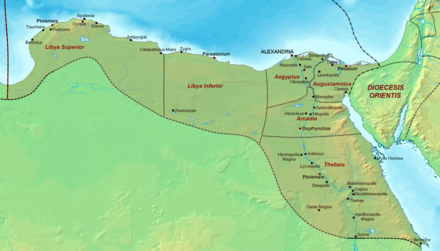Byzantine Period (Egypt)
The Byzantine era began in Egypt in the year 395 with the division of the Roman Empire , after which Egypt to the Eastern Empire was one (Byzantium). It can just as well be understood as a seamless continuation or second section of the late ancient Greco-Roman phase of the country and ended with the conquest of the country by the Arabs in 642.
meaning
The late antique epoch of Egypt was marked by the final assertion of Christianity , which had found many followers in Egypt, especially in Alexandria , early on. A wide variety of doctrines were preached by the various Patriarchs of Alexandria , some of which were enforced by force. At the same time, koinobism , the early monastic system, flourished on the Nile .
Chronological sections
At the time of the first Eastern Roman emperor Arcadius , the "founder" of the Egyptian Coptic Church , Schenute , was the head of the White Monastery near Sohag . Theophilus of Alexandria tried to enforce his doctrine that God was anthropomorphic , i.e. that he appeared in human form, against his opponents by force.
In 408 the young emperor Theodosius II ascended the throne of Ostrom as a child . Four years later Theophilus of Alexandria died. His successor was Kyrill , one of the most powerful churchmen of his time, who was able to enforce his theological positions bindingly for the imperial church at the ecumenical council of Ephesus in 431 and is still considered the most important founder figure of the Miaphysites . In Alexandria in 415 the great pagan philosopher Hypatia was murdered in the street by a Christian mob; but even after her there were pagan scholars in the city for decades .
Cyrill's successor Dioskur , who took over the patriarchal office in 444, was initially able to assert himself with his Monophysite teaching at the so-called Synod of Robbers of Ephesus in 449 . But only two years later there was a split at the fourth ecumenical council in Chalcedon : Pope Leo the Great rejected the Monophysite doctrine, and the majority of the council and Emperor Markian endorsed this position. However, the majority of the Egyptians stuck to the rejection of the council resolutions, which in the following 200 years repeatedly led to tensions between Egypt and Constantinople.
Emperor Markian also fought the Nubians and Blemmyes during his reign (450–457) . There is evidence of famine in Egypt in 502 . Otherwise, the country experienced, practically undisturbed by external attacks, a time of peace and an economic boom. Egyptian grain supplied Constantinople.
Emperor Justinian I issued new administrative rules for the country during his reign. Egypt was one of the richest and most important provinces of the Eastern Roman Empire in the 6th century. Ancient education was maintained in Alexandria for a long time, and even in the countryside there were people on the Nile who had received a classical Greek upbringing ( paideia ), as the example of Dioskoros shows. Under Justinian, however, in 535 or 537 the last officially tolerated pagan temple in Egypt, the Isis sanctuary of Philae , was closed by imperial soldiers. In the first years of his reign, Emperor Maurikios (582–602) had to put down the dangerous Abaskiron rebellion .
The long period of external peace did not end until the 7th century: in 619 the Sassanid Persians invaded Egypt under Chosrau II and took Alexandria (Third Persian rule); Chosrau II began to administratively integrate the country into his empire; There are various Persian papyri and clothes from the eleven years of Sassanid rule. But after the victory of Emperor Herakleios , the Persians withdrew again by 630.
The Eastern Roman triumph did not last long: the Arabs began with Islamic expansion in 632 . In 636 Damascus fell and the imperial army was decisively defeated in Syria. The Arab general Amr ibn al-As conquered Pelusium for his caliph Umar ibn al-Chattab and defeated an Eastern Roman army in 641 at Heliopolis , in 642 Alexandria fell. The early Islamic period began in Egypt . A few decades later, Greek was replaced by Arabic as the administrative language.
See also
literature
- Roger S. Bagnall , Klaas A. Worp: Chronological Systems of Byzantine Egypt. Brill, Leiden / Boston 2004, ISBN 978-90-04-13654-0 .
- Roger S. Bagnall: Egypt in the Byzantine World, 300-700. Cambridge Univ. Press, Cambridge UK / New York 2007, ISBN 978-0-521-87137-2 .
- Roger S. Bagnall: Currency and Inflation in Fourth-Century Egypt. In: Bulletin of the American Society of Papyrologists Supplements. Scholars Press, Chico CA 1985, ISBN 978-0-89130-790-7 .
- Roger S. Bagnall: Late Roman Egypt. In: Dictionary of the Middle Ages. No. 10, Scribner, New York, pp. 453-56.
- Alan K. Bowman: Egypt After the Pharaohs: 332 BC - AD 642 from Alexander to the Arab Conquest. British Museum Press, London 1986.
- Jean Gascou: Les grands domaines, la cité et l'état en Egypte byzantine. In: Travaux et Mémoires. No. 9, Paris 1985, pp. 1-90.
- Birger A. Pearson, James E. Goehring: The Roots of Egyptian Christianity. Fortress, Philadelphia 1986, ISBN 978-0-8006-2706-5 .
- Siegfried G. Richter : The Coptic Egypt. Treasures in the shadow of the pharaohs (with photos by Jo Bischof). Scientific Book Society, Darmstadt 2019, ISBN 978-3-8053-5211-6 .
- Christina Riggs (Ed.): The Oxford Handbook of Roman Egypt . Oxford University Press, Oxford 2012.
